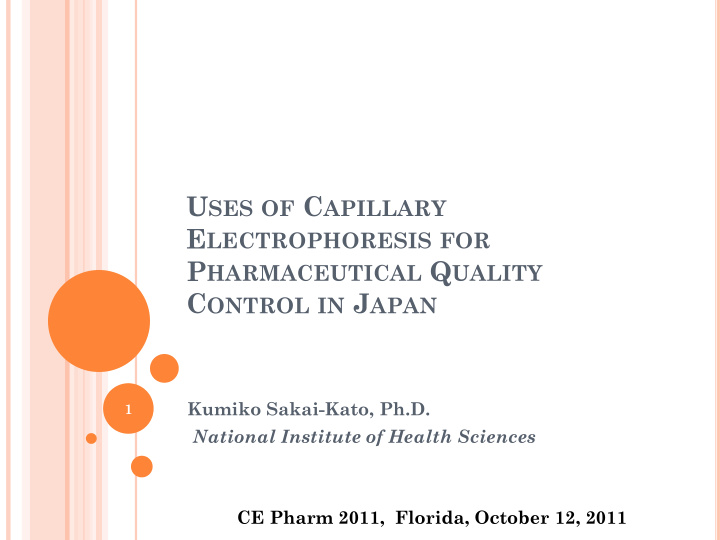



U SES OF C APILLARY E LECTROPHORESIS FOR P HARMACEUTICAL Q UALITY C ONTROL IN J APAN Kumiko Sakai-Kato, Ph.D. 1 National Institute of Health Sciences CE Pharm 2011, Florida, October 12, 2011
CE IN J APANESE P HARMACOPOEIA Capillary electrophoresis procedures are described in General Information of JP (Japanese Pharmacopoeia). The pharmacopoeial texts can now be used interchangeably in ICH regions as the result of the Q4B process. 2
CE IN J APANESE P HARMACOPOEIA General principles Apparatus 1.Capillary Zone Electrophoresis 2.Capillary Gel Electrophoresis 3.Capillary Isoelectric Focusing 4.Micellar Electrokinetic Chromatography 3
T HE USE OF CAPILLARY ELECTROPHORESIS IN J APAN Survey : how capillary electrophoresis is used for pharmaceutical quality control in pharmaceutical companies in Japan Members of The Japan Pharmaceutical Manufacturers Association (JPMA) 21 Companies, 32 respondents 4
T HE USE OF CAPILLARY ELECTROPHORESIS IN J APAN Target: Area Scale of business Process ≥ 30,000 < 200 development of 10% 5% < 1,000 drug O ther 9% substances 13% 3% Manufacturing < 30,000 < 2,000 12% Formulation 14% 14% development 31% < 10,000 < 5,000 Q uality 29% 19% control 41% 5
T HE USE OF CAPILLARY ELECTROPHORESIS IN J APAN Status of use ≥ 30,000 in use < 30,000 < 10,000 will be < 5,000 introduced < 2,000 not in use < 1,000 <200 0 20 40 60 80 100 6 (%)
A REA IN USE Other 4 Multiple answers Manufacturing 2 Quality control 10 Formulation development 13 Process development of drug substances 3 0 5 10 15 e.g.) Physicochemical properties of drug substances, specification, quality test (drug substances, drug products, excipients), stability test, monitoring for manufacturing method, shipping test Nucleic acid drugs 4% Drugs by chemical synthesis 27% 7 Biotechnological products 69%
E XAMPLE : G LYCOSYLATION A NALYSIS OF I G G PA800 eCAP PVA type Coated Capillary Flurorescent labelled with G0 APTS(8-aminopyrene-1,3,6-trisulfonate) G1A G1B G2 6 7 8 9 10 11 12 13 Time (min) 8 Courtesy of Dr. Nakashima (KAKETSUKEN)
Q. H AS CE BECOME PART OF THE SPECIFICATION AND TEST METHOD ? No 24% Yes 62% Under consideration 14% e.g.) • Purity test (CE-SDS, c-IEF, glycosylation mapping) • Identification test • Process control of drug substances 9
ADVANTAGES AND DISADVANTAGES OF CE IN DRUG DEVELOPMENT Advantages The variety of separation modes in the method. Quantitative performance, sensitivity, repeatability, automatization, short run time-compared to slab gel electrophoresis Small sample volumes, small effluent, characteristics of separation mode (e.g. ion analysis, charged compounds, highly polar compounds) -compared to LC The same software as for LC and GC 10 Simultaneous analysis of various components
ADVANTAGES AND DISADVANTAGES OF CE IN DRUG DEVELOPMENT Disadvantages Not yet in common use, High cost Not repeatable (injection volume, eluent time, response, quantification), Difficulties in fractionation and low sensitivity –compared to LC Instability in performance (unexpected trouble, clogging of the capillary tube, difficulty in system conditioning) Difficulty in the setting of analytical conditions Difficulty in peak characterization Discrepancy of analytical results between different companies’ instruments 11 Matrix effect
T HE USE OF MICROCHIP ELECTROPHORESIS IN J APAN Status of use Yes Under 23% considerat No ion 74% 3% Other(e.g. physicochemical properties) 4 0 Manufacturing Quality control 1 Formulation development 3 CE-SDS 0 Process development of drug substances Glycosylation mapping 12 0 1 2 3 4 5
G ENERAL C OMMENTS FROM USERS CE will become a more important method if it is applied to more chemical synthesis drugs. Great skill is required to get data with good repeatability. 13
R EQUESTS TO MAKERS FROM USERS Devices to connect CE and MS Standardization of instrument specification between CE makers. Improvements in injection repeatability, automation of analytical optimization, and miniaturization of equipment Improvement of sudden instability in results Improvement of difficulties in injecting samples to equipment These improvements are necessary to enable an 14 effective system suitability test.
R EQUESTS TO REGULATORS FROM USERS Standardization of method validation in purity test of therapeutic antibodies e.g.) - Accuracy of response factor for fluorescently-labeled antibodies - Robustness Standardization of injection method and washing method Standardization of method of calculating isoelectric point 15
C ONCLUSION CE is an analytical method with many advantages such as quantitative performance, sensitivity, and short run time. However, there are some difficulties in the setting of analytical conditions, and peak characterization. By improving these difficulties, CE can be in more common use as methods for characterization, quality controls, and specification. 16
A CKNOWLEDGEMENT National Institute of Health Sciences (NIHS) Dr. Kawanishi Dr. Yamaguchi Dr. Kawasaki Dr. Okuda Pharmaceutical and Medical Devices Agency (PMDA) Dr. Sakai KAKETSUKEN Dr. Nakashima CE Pharm 2011 Organizing Committee 17
Thank you for your attention! 18
Recommend
More recommend